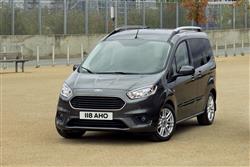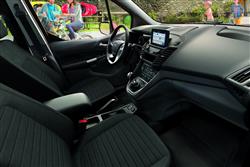This is a sample, showing 30 seconds of each section.
TOUR BUS (some text hidden) SECTIONED_fordtourneoconnect301014
By Jonathan Crouch
Introductionword count: 61
Ford's Tourneo Connect, sold between 2012 and 2020, may have commercial roots but it packaged them in a way that practical family folk will like. Cars of this kind used to be fairly crude: this one was anything but, almost certainly bigger and more affordable than the conventional compact People Carrier you might have been thinking of made in this period.
Modelsword count: 7
[diesel] 1.5 & 1.6 TDCi [petrol] 1.0
Historyword count: 271
Think of compact but spacious People Carrying vehicles from the 2012-2020 period and you'll probably think of cars like Ford's C-MAX, Renault's Scenic or Citroen's C4 Picasso. Increasingly though, customers looking for true practicality are often finding models like these a bit too polished or, to put it bluntly, not something you'd be happy about piling a wet dog into. It never used to be that way. The first generation versions of these cars were resolutely practical things. Today, while they still retain the space and the clever folding seats, the ambience is one of club class travel rather than rugged versatility. That's where cars like the Ford Tourneo Connect model of 2012-2020 come in. Yes, this model is based on a van. No, that needn't be an issue, unless, rather pretentiously, you're worried that your image might be tarnished by such a thing. Unfortunately, most buyers seem to be, which is one reason why sales of van-based MPVs are so relatively small in this country. The other is the lack of choice on offer, with only Citroen, Peugeot and Fiat actively promoting such models within their passenger car ranges - though other brands sell similar such vehicles through their commercial vehicle divisions. Ford though, reckons it can rejuvenate this market segment and the excellence of its second generation Transit Connect van gave the brand the perfect platform from which to do just that. This is, we were told, was the perfect blend between sophistication and simplicity. But would your family really want one? This model sold until 2021, when it was then replaced by a new generation Volkswagen Caddy-based design.
What You Getword count: 1328
What's the best shape you can make any car if you want it to be practical? Square is the answer, just like this Ford. It'll please you if you're one of those shopping in this market who think the whole idea of trying to make a People Carrier sleek and stylish is really rather silly. That's not to say that an MPV can't be smart and well turned out of course. This one seems to be, with neat, practical aesthetics that, from the front at least, won't immediately leave potential buyers thinking this to be one of Ford's Commercial Vehicles. Slender, swept-back headlights complete the brand's familiar 'Kinetic Design' look that's characterised as usual by a big, bold trapezoidal lower grille. Aesthetically then, the stylists did just enough: this is very much a compact People Carrier of its time. And one of much greater Focus, not least because Ford's best-selling family hatch provides most of the underpinnings here. But we mean that primarily because, unlike its predecessor, this Tourneo Connect no longer had to try and be all things to almost all customers as Ford's van-based alternative in the compact people carrying segment. Let us explain. The old version of this car was the one-size-fits-all van-based alternative to all of Ford's more car-like compact People Carriers. This design though, tried to be more specific. Ford introduced a smaller Tourneo Courier model in this period to offer a more practical option to its B-MAX MPV. Leaving this car to offer the same alternative to C-MAX buyers, people who might otherwise have turned to practically spacious van-based rivals in this period like Citroen's Berlingo Multispace, Peugeot's Partner Tepee and Fiat's Doblo. All of these three competitors provided seven seat option packages in this time, so Ford also offered a lengthened Grand Tourneo Connect version of this car for those needing three seating rows. Whichever body style you choose, the LCV origins are, as you'd expect, most obvious from the boxy side profile and of course, the slab-sided rear end but, as we've said, that's all to the good when it comes to the space you can expect inside, especially in a cargo area that isn't very easy to get to if you find yourself backed into a tight parking bay. That's because the huge rear tailgate requires quite a lot of space to be left behind before it can be raised and there's no option to simply open the tailgate glass to get smaller bags in and out. Still, on the plus side, when it is up, you get the kind of shelter from the elements that a conventional rear hatch just can't provide. But just how much space is there in the boot? Well, not quite as much as you'd get in the direct van-based opposition. You're talking about 30% less than you'd get from a Berlingo Multispace, a Partner Tepee or a Doblo. But don't be put off: there's still an awful lot of cargo room, the 1,029-litre capacity being almost double what you could expect from the kind of Ford C-MAX that with the same engine, would cost you about 15% more. Compact car-like MPVs from other brands are equally pathetic in comparison. The low boot floor also means that chucking stuff in the back couldn't be easier, whether the item in question is a mountain bike or the family dog. Fold the rear bench and the news gets even better. The 2410-litre capacity that frees up is significantly greater (410-litres more in fact) than the total that in the same configuration you could expect from a much larger Ford S-MAX in the next class up - a car that with the same engine would cost you around 40% more. The space available is even slightly more than you could expect in the same configuration from what is supposedly Ford's biggest MPV, the even more expensive Galaxy. And if you want to, you can go further and free up even more capacity by taking the rear seats out completely, assuming you've got somewhere to store them and a mate to help you (as they're heavy). Do that, then stick a sheet down to protect the carpet and, should you ever need it, you've got yourself a ready-made van for weekend removals. If the stuff to be carried is beyond the 1.8m length of the cargo area floor, there's even a folding front passenger seat too. This is in short, a uniquely flexible family car. But then it's based on a commercial vehicle. You expected lots of room for packages. How will it fare when it comes to carrying people? Pretty well we think. Getting into the rear, the first thing you'll notice is that the doors slide rather than open conventionally, which is totally appropriate on a car of this kind and something you'll be thankful for when the kids are getting in and out in tight parking spaces. Slide the door back and you'll find an aperture that the largest in the class too. And inside? Well it's a bit disappointing that Ford fitted a fixed rear bench rather than the individual sliding separate seats that rivals provide. And that this bench doesn't either slide backwards and forwards or recline for greater comfort on longer trips. Still, on the plus side, it shouldn't be too difficult to fit three adults in the back on short to medium-length trips and of course headroom from the boxy shape is ample, even if you're carrying loftier folk and/or have a car whose original owner fitted the optional panoramic glass roof. From new, there was also the option of useful lidded aircraft locker-style overhead storage and a storage bin recessed into the floor - though curiously, unlike rivals, Ford only gave you one of these, directly behind the driver's seat. Kids meanwhile, will like the low window line and will appreciate it if you find a car whose original owner specified the seatback tables that were optional on lower-spec models. At the wheel, it's all very car-like, though in a sensible, utilitarian sort of way. The commercial origins of course, mean that you don't get the fashionable soft-touch plastics you'd find in, say, a C-MAX - but then, are these really necessary on a practical family car? What's more important is that build quality from the Spanish Valencia factory was strong and the wipe-clean surfaces provided are tough and durable. You view a clearly presented set of familiar Ford instruments through a four-spoke wheel that moves for both reach and rake. And you immediately appreciate a supportive driver's seat that's eight-way-adjustable on most models, making it easier to get comfortable than it would be in some competitors. Talking of comfort, we like the way the gearstick sprouts from the bottom of the dash rather than the floor, so it falls to hand more easily. The mobile phone-inspired centre console switchgear layout comes straight from the Focus and is relatively simply to use, once you get used to the rather bewildering array of buttons and the fact that the infotainment screen at the top of the dash is a little small. On the positive side, the buttons are all quite large so in colder months, you can if necessary operate them wearing gloves. There's plenty of practicality too, though it's a pity the base model didn't get the lockable glovebox you find further up the range. Otherwise, there's decent cubby storage for the paraphernalia of everyday working life, including reasonably-sized door bins, plus two cup holders and a coin holder by the gearstick as well as a usefully deep bin further back where you'll find aux-in and iPod sockets. There's also a useful cubby above the instrument panel complete with 12v socket and an equally practical overhead storage area we'd urge you not to use for heavier items - unless you want to open up the possibility of being clonked on the head the next time you do an emergency stop.
To see the full road test text contact us on 0330 0020 227
Pictures (high res disabled)
.jpg)
.jpg)
|
.jpg)
|

| |||
.jpg)
|

|
Scoring (subset of scores)
Category: MPV People Carriers
| Performance | |
| Handling | |
| Comfort | |
| Space | |
| Styling, Build, Value, Equipment, Depreciation, Handling, Insurance and Total scores are available with our full data feed. | |




.jpg)
